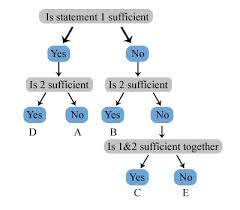Introduction:
A data sufficiency aptitude question contains an example accompanied by two statements providing certain information. Hence the problems under this blog, test the ability of the students to find out whether a given set of data is sufficient or not to answer the question. There is no need to solve the problem to arrive at an answer. Thus, it becomes the test of knowledge of the formula required and the application of these to solve the "real-life" situations.
To solve or not to solve? First, when one encounters GMAT, Data Sufficiency aptitude questions seem to be fairly simple and easy to solve. Then, we realize that we don't need to solve. The third step happens when Problem Solving score goes up, and Data sufficiency stays the same or falls down. Then we get back to solving the question, so the pattern goes like this: solve >> not solve >> solve.
There is a general belief that one should not solve DS since all it asks is enough or not enough to answer. In fact, many textbooks tell not to solve. However, under “do not solve” is implied to do the job of compiling an equation, get it to the final form and stop only when all you have to do calculations. To get the DS right, you need to solve, but you don't need to calculate.

Note:
(i) The students must be able to determine minimum information required to solve the problem in order to arrive at the most appropriate choice.
(ii) Apart from the information given in the question and the statements, nothing can be taken for granted (assumed).
EXAMPLE PROBLEMS Type - I (Two statement type)
Directions :
Each of the questions given below consists of two statements numbered I and II given below. You have to decide whether the data provided in the statement(s) is/are sufficient to answer the given question. Read both the statements and mark the answer as
(a) If the data in both statement I and II are not sufficient to answer the question.
(b) If the data in statement I and II together are needed to answer the question.
(c) If the data in statement I alone is sufficient to answer the question.
(d) If the data in statement II alone is sufficient to answer the question.
1. The average age of W,X,Y and Z is 30 years. How old is Y?
I) The sum of age of W and Y is 60 years.
II) Z is 10 years younger than Y.
Ans : a
Click here for more aptitude questions